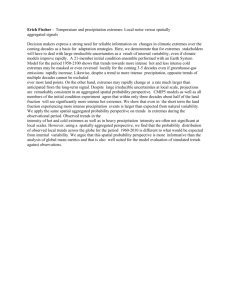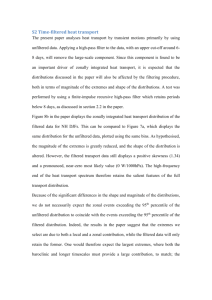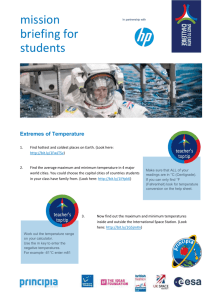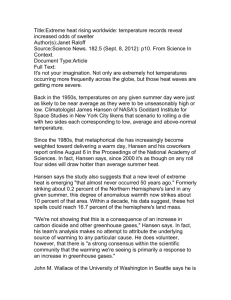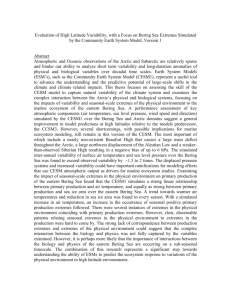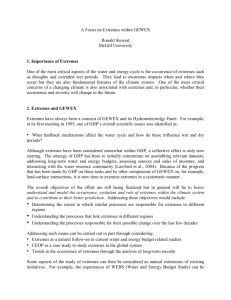October 24, 2005 - Drought Research Initiative
advertisement
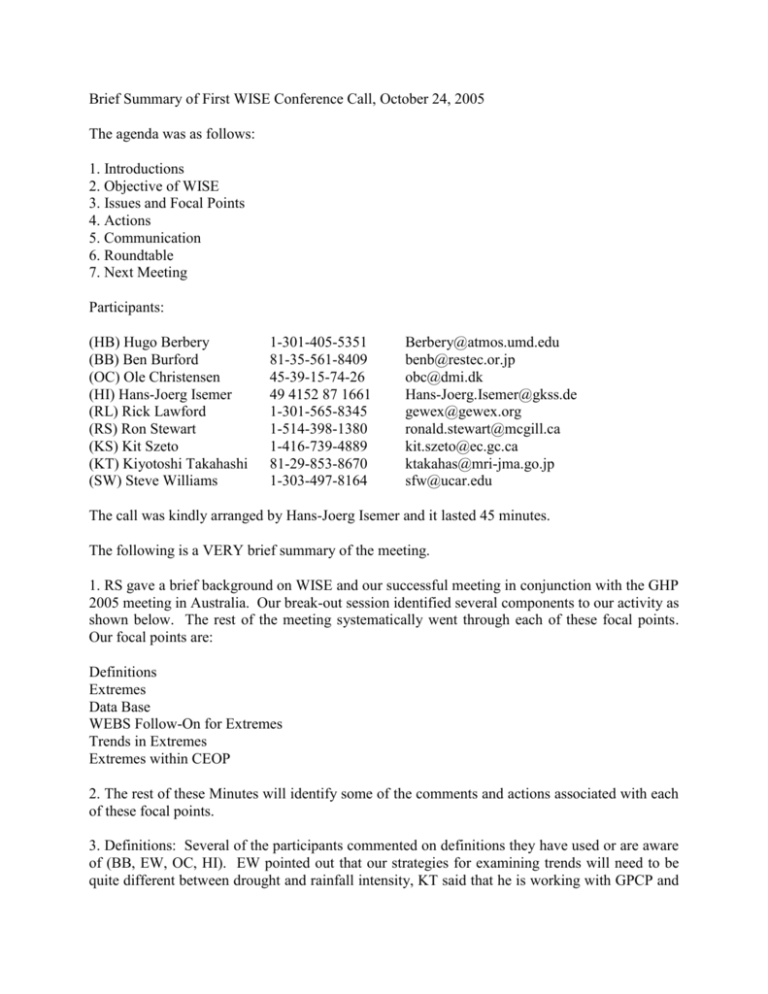
Brief Summary of First WISE Conference Call, October 24, 2005 The agenda was as follows: 1. Introductions 2. Objective of WISE 3. Issues and Focal Points 4. Actions 5. Communication 6. Roundtable 7. Next Meeting Participants: (HB) Hugo Berbery (BB) Ben Burford (OC) Ole Christensen (HI) Hans-Joerg Isemer (RL) Rick Lawford (RS) Ron Stewart (KS) Kit Szeto (KT) Kiyotoshi Takahashi (SW) Steve Williams 1-301-405-5351 81-35-561-8409 45-39-15-74-26 49 4152 87 1661 1-301-565-8345 1-514-398-1380 1-416-739-4889 81-29-853-8670 1-303-497-8164 Berbery@atmos.umd.edu benb@restec.or.jp obc@dmi.dk Hans-Joerg.Isemer@gkss.de gewex@gewex.org ronald.stewart@mcgill.ca kit.szeto@ec.gc.ca ktakahas@mri-jma.go.jp sfw@ucar.edu The call was kindly arranged by Hans-Joerg Isemer and it lasted 45 minutes. The following is a VERY brief summary of the meeting. 1. RS gave a brief background on WISE and our successful meeting in conjunction with the GHP 2005 meeting in Australia. Our break-out session identified several components to our activity as shown below. The rest of the meeting systematically went through each of these focal points. Our focal points are: Definitions Extremes Data Base WEBS Follow-On for Extremes Trends in Extremes Extremes within CEOP 2. The rest of these Minutes will identify some of the comments and actions associated with each of these focal points. 3. Definitions: Several of the participants commented on definitions they have used or are aware of (BB, EW, OC, HI). EW pointed out that our strategies for examining trends will need to be quite different between drought and rainfall intensity, KT said that he is working with GPCP and other information, and OC is using regional models with ‘standard’ definitions. BB offered to organize the various inputs on definitions for our next meeting. HI noted definitions being used by e.g. IPCC and major EU-funded projects such as STARDEX, which might be useful to WISE. Action: Participants should forward their material to BB (benb@restec.or.jp) who will collate it. 4. Data base: SW offered to initially extract information from the 18 year “Earth Week” newsletter and many other web sites are already posted on our WISE web site. Several people commented on the Dartmouth Floods web site as an example of a very useful site. RL mentioned that he was aware of a 50 year global drought dataset. BB mentioned a global tropical cyclone climatic atlas and he asked if there was a special web site on monsoons. Everyone to send updated information on current extremes datasets to SW but they should first check to see if it is already listed on our web site. We may need to re-organize our web site to more clearly reflect some of these existing and new datasets. In many cases though, the available extremes datasets do not precisely identify the timing, magnitude and location of the extreme. http://www.joss.ucar.edu/ghp/extremes/ Action: Please check our WISE web site, send other database information to SW (sfw@ucar.edu) for additions, and perhaps suggest if we could re-organize our collection of extremes information. 5. WEBS Follow-On: KS briefly presented the work he has done to bring together model and observational datasets to characterize some years of the recent drought over the Canadian Prairies. This follows directly from WEBS activities. HB mentioned that he has done WEBSrelated studies over the GAPP and LPB regions. RS mentioned that other working groups, such as GCSS, have had great success in focusing in great detail on individual case studies. Here, rather than a cloud system, we are dealing with drought although extended wet periods are of course directly linked with cloud systems. KS will prepare a short paragraph on the Prairies work and this could act as one initial focus with other cases to follow. Action: KK (kit.szeto@ec.gc.ca) will prepare a paragraph on this ‘case study’ (see KK’s paragraph below). 6. Trends: A key question that we need to consider is whether there is a need for us to do this. A number of comments were made in connection with trends. These include the following. HB mentioned work on drought trends over the US South West and precipitation trends over South America. No one was sure of a comprehensive assessment of trends in drought. BB commented that, in his literature search on extremes, he found that a high percentage of articles on extreme precipitation were articles on trends (there are articles on trends in extreme precipitation for Italy, Spain, India, the US, etc.). BB again offered to collate the information and send it out. HI recalled his presentation on BACC (BALTEX Assessment of Climate Change for the Baltic Sea Basin) which is currently ongoing and is expected to review existing evidence on both observed trends and projections. KS asked whether we will also examine future trends in extremes and this will be added to our next meeting’s agenda. OC mentioned that he has access to a great deal of model information to examine this. Action: Send specific information to BB (benb@restec.or.jp) for collating. 7. Extremes and CEOP: BB is developing a mathematical model of extremes and intends to apply this to the occurrence of extremes during the CEOP period and this will also lead to examining the characteristics of these extremes, their inter-connections, as well as their impacts. Action: BB (benb@restec.or.jp) and RS (ronald.stewart@mcgill.ca) will continue to update the group on this effort. 8. We agreed to meet face-to-face at the upcoming CEOP 2006 meeting. 9. Next conference will be on November 21 at the same ‘Time”. Material arising from this first conference call will be available beforehand. More details will be sent later. 10. The draft agenda of the Nov 21 conference call is: Introductions Present Status Focal Point Updates definitions data base WEBS follow-on trends Extremes and CEOP Future trends in extremes Other Updates Summary of Actions Roundtable Next meeting ………….. Brief write-up from KS (kit.szeto@ec.gc.ca) in relation to WEBS Follow-on (Item #5 above): The first WISE case study will be a WEBS type diagnostic study of a severe drought event that occurred over the Canadian Prairies from 1999-2003. The objectives of the study are to (a) evaluate the surface and atmospheric water and energy budgets for the region during the 19972002 period; (b) assess the validity and variability of the budgets that are derived from different source datasets and (c) examine the deviations of the budgets from climatological values for this extreme hydrometeorological event. In addition to these scientific objectives, this pilot study will also attempt to establish mechanisms (e.g., in data transfer and task sharing) to facilitate future WISE collaborative studies. The water and energy budgets will be evaluated by using mainly global and regional (re-)analysis and model datasets (right now we have data from NCEP-R2, ERA40, CMC and the CRCM) with validation data obtained from both in situ and remotelysensed measurements. Apart from the evaluation of standard WEBS variables and parameters, diagnostics that are useful either in the characterization of drought events or in the understanding of their dynamics, such as precipitation recycling or moisture source tracing diagnostics, will also be conducted. WISE members are encouraged to participate in the case study through the contribution of measured, assimilated, modeled or remotely-sensed data for, and in carrying out, the diagnostic calculations.

